Indexed In
- Academic Journals Database
- Open J Gate
- Genamics JournalSeek
- JournalTOCs
- ResearchBible
- Ulrich's Periodicals Directory
- Electronic Journals Library
- RefSeek
- Hamdard University
- EBSCO A-Z
- OCLC- WorldCat
- Scholarsteer
- SWB online catalog
- Virtual Library of Biology (vifabio)
- Publons
- MIAR
- Geneva Foundation for Medical Education and Research
- Euro Pub
- Google Scholar
Useful Links
Share This Page
Journal Flyer

Open Access Journals
- Agri and Aquaculture
- Biochemistry
- Bioinformatics & Systems Biology
- Business & Management
- Chemistry
- Clinical Sciences
- Engineering
- Food & Nutrition
- General Science
- Genetics & Molecular Biology
- Immunology & Microbiology
- Medical Sciences
- Neuroscience & Psychology
- Nursing & Health Care
- Pharmaceutical Sciences
Opinion Article - (2025) Volume 16, Issue 2
Integrating Machine Learning Approaches in Genomic Data Analysis
Michael Anderson*Received: 29-May-2025, Manuscript No. JDMGP -25-29765; Editor assigned: 31-May-2025, Pre QC No. JDMGP -25-29765; Reviewed: 14-Jun-2025, QC No. JDMGP -25-29765; Revised: 20-Jun-2025, Manuscript No. JDMGP -25-29765; Published: 28-Jun-2025, DOI: 10.35248/2153-0602.25.16.384
Description
The rapid expansion of genomic data generated by high-throughput sequencing technologies has transformed the landscape of biomedical research. The increasing availability of large-scale genomic datasets, spanning populations and disease cohorts, has created both opportunities and challenges for computational biology. Traditional statistical approaches have provided valuable insights into gene-disease associations, but the complexity, volume and dimensionality of modern genomic data demand more advanced computational strategies. Machine Learning (ML) has emerged as a powerful tool in this context, enabling the discovery of patterns and relationships that are difficult, if not impossible, to capture with conventional methods. Machine learning models excel in processing high-dimensional genomic datasets that contain millions of features, such as Single Nucleotide Polymorphisms (SNPs), copy number variations and structural alterations. Deep learning, in particular, has shown promise in handling this scale of complexity. For instance, convolutional and recurrent neural networks have been successfully applied to whole-genome sequencing data to uncover subtle associations between genomic variants and disease phenotypes. These models not only identify known associations but also detect novel patterns that could provide insights into disease mechanisms and therapeutic opportunities.
One of the most significant applications of machine learning in genomics is predicting disease susceptibility based on individual genetic profiles. By training supervised learning models on thousands of annotated genomic samples, researchers can identify combinations of variants that collectively contribute to disease risk. Such predictive models are particularly valuable for conditions with complex, polygenic inheritance, including cardiovascular diseases, diabetes and certain psychiatric disorders. Accurate risk prediction supports early interventions, preventive healthcare and personalized treatment strategies. Cancer genomics is another area where ML tools have proven indispensable. A major challenge in oncology is distinguishing driver mutations, which contribute directly to tumorigenesis, from passenger mutations, which are biologically neutral. Machine learning algorithms are adept at making this distinction by integrating sequence data, mutation frequency, functional annotations and evolutionary conservation. Identifying true driver mutations is essential for prioritizing therapeutic targets and designing precision oncology strategies.
Despite these successes, challenges remain in the application of ML to genomic data analysis. A key issue is model interpretability. While deep learning models achieve high predictive accuracy, they often function as “black boxes,” making it difficult to understand the biological rationale behind predictions. This lack of transparency is problematic in clinical applications, where interpretability is essential for building trust among healthcare providers and patients. Consequently, there has been growing interest in developing explainable AI methods that provide human-interpretable explanations of model outputs. Another limitation involves biases in training data. Genomic datasets often overrepresent individuals from specific populations, particularly of European ancestry, leading to models that perform poorly when applied to underrepresented groups. Such disparities can exacerbate health inequalities if not addressed. To overcome these challenges, researchers emphasize the need for more diverse genomic datasets and the implementation of fairness-aware machine learning strategies that ensure equitable predictive performance across populations.
The integration of multiple omics data layers offers another frontier for machine learning in genomics. By combining genomics with transcriptomics, proteomics, epigenomics and metabolomics, researchers can develop multi-modal models that capture the complex interplay between molecular layers. Data fusion techniques, including network-based models and integrative clustering, enhance classification accuracy and provide deeper insights into disease biology. For example, integrating genomic and epigenomic data has improved predictions of cancer progression, while incorporating proteomics has clarified mechanisms underlying treatment resistance. The computational infrastructure required to process these massive datasets is equally important. Advances in high-performance computing, parallel processing and cloud-based platforms have enabled the analysis of petabyte-scale genomic datasets. These resources ensure that machine learning models can be trained efficiently and deployed globally, fostering large-scale collaboration among research institutions.
Looking to the future, the field is moving toward collaborative and federated learning approaches. In federated learning, models are trained across multiple institutions without requiring the transfer of sensitive patient data, thus preserving privacy while benefiting from diverse datasets. This approach is particularly relevant in genomics, where privacy concerns and data-sharing restrictions often limit collaboration. Coupled with secure computation techniques, federated learning holds promise for building globally representative models without compromising individual confidentiality. In conclusion, machine learning is reshaping genomic data analysis by offering powerful methods for disease risk prediction, driver mutation identification and multi-omics integration. While challenges such as interpretability, data bias and computational demands remain, ongoing advancements in algorithms, infrastructure and collaborative frameworks are addressing these barriers. As the field progresses, machine learning will not only deepen our understanding of human biology but also accelerate the translation of genomic discoveries into clinical practice, ultimately advancing the vision of personalized medicine.
Citation: Anderson M (2025). Integrating Machine Learning Approaches in Genomic Data Analysis. Journal of Data Mining in Genomics & Proteomics. 16:384.
Copyright: © 2025 Anderson M. This is an open-access article distributed under the terms of the Creative Commons Attribution License, which permits unrestricted use, distribution and reproduction in any medium, provided the original author and source are credited.

